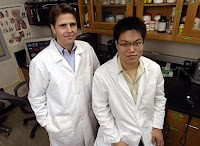Researchers probe health and safety impacts of nanotechnology
GAINESVILLE, Fla. — University of Florida engineering student Maria Palazuelos is working on nanotechnology, but she’s not seeking a better sunscreen, tougher golf club or other product — the focus of many engineers in the field.Instead, Palazuelos, a doctoral student in chemical engineering, is probing the potentially harmful effects of nanotechnology by testing how ultra-small particles may adversely affect living cells, organisms and the environment. But this is no scene from Michael Crichton’s novel “Prey” about nanotechnology run amok. Rather, this is a real-world endeavor grounded in solid science.
“We don’t want to look back in 50 years if something bad has happened and say, ‘why didn’t we ask these questions?’” Palazuelos said.
Palazuelos is a member of a small interdisciplinary group of UF faculty members and students, the UF Nanotoxicology Group, whose work is rapidly becoming more timely as manufacturers increasingly turn to the super-small tubes, cylinders and other nanoparticles at the heart of nanotechnology.
There are already more than 400 companies worldwide that tap nanoparticles and other forms of nanotechnology, and regulatory agencies such as the Environmental Protection Agency, the Food and Drug Administration and the Occupational Health and Safety Administration are closely examining whether new regulations are needed to guard against potentially harmful but currently unknown effects, said Kevin Powers, associate director of UF’s National Science Foundation and Particle Engineering Research Center. These agencies are turning to university researchers for help in making those kinds of determinations, he said.
“Before we start producing these materials in large quantities to go into everyday products, we should know what effect they have on our health and the environment,” he said.
The UF group consists of about 10 faculty members and a half-dozen students from UF’s engineering, medical and veterinary colleges. With funding from UF and agencies including the EPA, National Science Foundation and the U.S. Air Force, the researchers have at least eight projects aimed at answering questions ranging from how nanoparticles affect fish to whether nanoparticles can penetrate skin. The researchers have presented several lectures at conferences and have several papers published or undergoing review.
Powers said the health and environmental effects of common metals and materials are well-known. The question for the researchers is whether the effects change when the metals and materials take the form of nanoparticles – and whether these nanoparticles become more or less hazardous based on shape and size. “It’s complicated,” he said. “In many cases, we lack basic knowledge of the properties and the behavior of the particles themselves.”
Palazuelos is investigating what happens to living cells when confronted with aluminum nanoparticles. For the type of cells she has tested, the cells can readily absorb the aluminum nanoparticles, and there is a correlation between size, shape and toxicity. That said, Palazuelos stressed that it is far too early to conclude that aluminum nanoparticles are harmful to human health. Epidemiological studies evaluating years of exposure to aluminum in foundry workers and welders have not shown dramatic health effects as long as basic safety and exposure guidelines are followed, she said.
“It is a long way from isolated tissue studies to the extrapolation of these results to human health,” she said. “However, a fundamental understanding of the nanoparticle-cell interactions will be very useful in this field.”
Copper and some other metals are known to be toxic to fish and other aquatic wildlife. UF toxicologist David Barber is investigating whether nanoparticles made of these metals are more toxic than standard soluble forms of the metals. As part of his research, he has exposed zebra fish, a species commonly used in laboratory tests, to various concentrations of copper nanoparticles and compared the results with those induced by copper sulfate.
His results so far show that the 30-nanometer, spherical copper nanoparticles are lethal to zebra fish, though less toxic than copper sulfate. However, the way the copper nanoparticles cause damage is different. “Both of them are causing lethality by affecting the gill,” Barber said. “The lesion is slightly different, and the gene expression response in the gills is very different.”
Barber said he hopes to determine whether the size or shape of the nanoparticle is key to its effects. If that’s the case, it could mean a lot of work ahead for regulatory agencies.
“Typically, when you test a chemical, the response is the same regardless of formulation. Aspirin is always aspirin,” Barber said. “If all of a sudden every time you change the size or the shape of a nanoparticle you have to retest it; that’s a lot of testing.”
Credits Writer Aaron Hoover, ahoover@ufl.edu, 352-392-0186, Source Kevin Powers, kpowers@erc.ufl.edu, 352-846-1194, Source David Barber, dbarber@ufl.edu, 352-392-4700, ext. 5540, © University of Florida, Gainesville, FL 32611; (352) 392-3261.
Technorati Tags: nanofibers or Nanoscientists and Nano or Nanotechnology and nanoparticles or Nanotech and nanotubes or nanochemistry and nanoscale or nanowires and Nanocantilevers or nanometrology and Environmental Protection Agency or National Science Foundation and Nano-Hazard or University of Florida





















